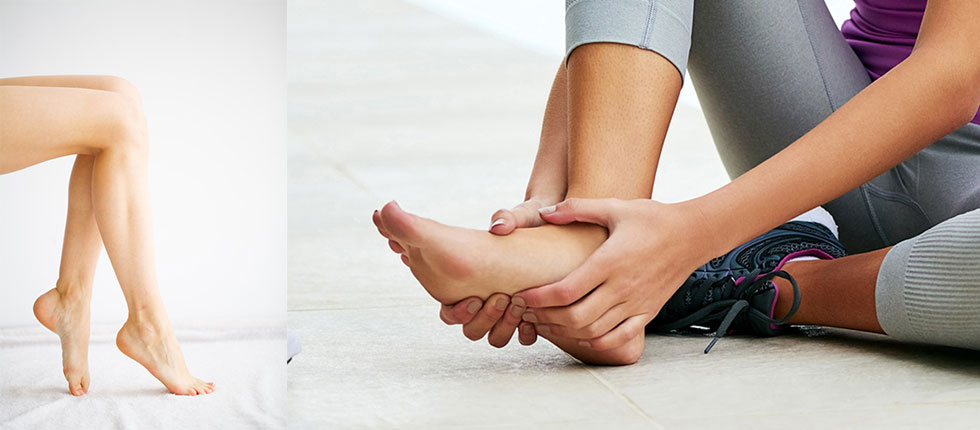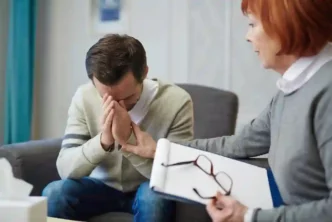When the blood flow is quite slow or the blood starts pooling inside veins, the platelets tend to stick together and form a blood clot. Such a condition of blood clot(s) inside veins is called deep vein thrombosis (DVT). This vascular health condition arises when the valves of the veins are not strong enough to ensure the normal blood flow in one direction.
Though DVT can occur to anybody with poor vascular health but people who are obese with age above 50 years are the most vulnerable to develop blood clots in legs.
Therefore, it is necessary to keep a constant check on any kind of abnormal symptoms. The sooner this condition of blood clot is detected, the lesser pain and other problems the person has to suffer.
Here are the 5 warning signs of deep vein thrombosis
1.Discoloration or redness of the skin- This is the most common sign of forming a blood clot under the skin. If there is a blood clot in a person’s leg, they may experience some discoloration of some area of the skin on the leg. The skin surrounding the blood clot can look pale or even turn bluish to reddish in color. The intensity of the discoloration or the reddening of the skin depends upon the severity of the blood clot (size and shape of the lump).
2.Intense pain and cramping- A blood clot in the leg usually causes an intense cramping pain. The cramp or soreness starts in the calf muscles and then reaches other parts of the legs as well. However, this cramping pain does not get better with time. It usually worsens and does not reduce even after walking or stretching.
3. Swollen and heavy legs- Swelling is another common sign associated with deep vein thrombosis. If you have a blood clot in the veins of your leg, you may notice swelling on one side of your foot, ankle or leg. In addition to the swelling, your legs may feel a little heavy and you may face discomfort while carrying out routine activities.
4. Twisted bulging veins- People who suffer from twisted and bulging out veins have increased risk of developing blood clots in the legs. Such damaged veins with blood pooling inside them are called varicose veins. Varicose veins are among the major prevailing risk factors of deep vein thrombosis.
5. Warmth around the blood clot- This is another prominent indication that you may have a clot in one of your leg veins. People with DVT usually notice warm patches in their affected leg, with the patch being a little warmer than the rest of the leg. This condition grows worse as the blood clot grows in size. The warm patch can be either a small region around the clot, or the whole of the calf region.
Why is it necessary to attend to deep vein thrombosis without delay?
Deep vein thrombosis is a very discomforting condition, and if left untreated, the symptoms are bound to become severe. As the blood clot grows, so does the risk of complications. The most common complications associated with deep vein thrombosis are:
Pulmonary embolism- If the blood clot breaks free from the veins, it can travel through the bloodstream and get lodged in any artery or even the lungs. This is a serious condition and in severe cases, may even result in a stroke.
Chronic venous insufficiency- The presence of blood clot in the veins for a long time can cause permanent damage to the vein walls and valves. As a result, they may lose their functioning and this condition is known as chronic venous insufficiency.
Post-thrombotic syndrome- If you leave DVT unattended for a long time before undergoing the treatment, the symptoms may stay with you even after you get the blood clot removed. Prolonged blood clots can cause long-term swelling and pain in the legs, a condition also known as post-thrombotic syndrome.
Now that you understand how frightening blood clots can be, you must make a wise decision and get in touch with a vascular specialist if you notice any signs and symptoms. A timely diagnosis and proper treatment measures can save you from enduring the complications of DVT.
To deal effectively with deep vein thrombosis follow these:
Management tips and home remedies
- Vitamin E- Vitamin E acts as a natural blood thinner and can help in preventing blood clots to a great extent. So if you are struggling with DVT symptoms, olive, corn and soybean oils can come to your rescue.
- Cayenne Pepper and ginger- Both of these work as natural immunity boosters and strengthen the vascular system of the body. Also, cayenne pepper and ginger tend to stimulate the blood flow throughout the body. So the chances of pooling of blood or platelets sticking together minimize to a great extent.
- Walking and exercising- Staying active helps in boosting blood circulation in the legs and thus prevents more blood cells from clumping together to form blood clots.
- Elevate the legs for some time – You can use a couple of pillows to keep your legs elevated. This would allow the proper flow of blood and relieve some of the pain and heaviness in the legs.
- Compression stockings- Compression stockings help to minimize the pressure on the legs and thus are the best thing if you want to carry on with your routine tasks with minimal discomfort.
Medicines that specialists prescribe for deep vein thrombosis
DVT medicines usually consist of anticoagulants or blood thinners. These medications prevent further blood clots from forming and existing blood clots from growing in size. This allows the body to naturally break down the blood clots over time. These medicines can be in the form of pills as well as shots. Heparin and Warfarin are the two most commonly prescribed medicines for deep vein thrombosis.
Although these medicines are widely popular, they may take quite long to work in the case of large blood clots. Therefore, if you are looking for fast relief from the symptoms of deep vein thrombosis, you should consider the advanced laser treatment.
Note: Do not take anticoagulants without consulting with a medical professional. These medicines can have severe side effects if not taken properly. Therefore indulging in self medication is just not a good idea.
For complete and permanent relief from blood clot choose laser treatment
Laser treatment for deep vein thrombosis is an advanced treatment procedure that enables the patient to get rid of the blood clots in just one day. In this procedure, the surgeon uses high intensity laser energy to remove or evaporate the blood clot present in the vein of the leg. No cuts are required during the laser surgery. This means that the laser surgery is 100% painless and minimally invasive.
Other benefits of laser treatment
- No need for bandage after the treatment as there are no incisions carried out
- No side-effects of the laser treatment
- Nil chances of the recurrence of blood clots in the same veins again
- No long term medication or painkillers needed after undergoing the laser treatment
- Same day discharge
- Short and smooth recovery period of just 2-3 days maximum
- No major restrictions after complete recovery
If you are looking for a good hospital for undergoing DVT treatment, you can contact Pristyn Care. They are associated with the best vascular specialists and hospitals in Delhi and almost all the other major Indian cities. They offer the most advanced treatment technique for deep vein thrombosis and have a great success rate in treating the condition. You can easily book your appointment with one of their specialists online and then consult the doctor for the best treatment of blood clots.
The Bottom Line
Ignoring the warning signs of the blood clot in legs or taking it casually for a long time can result in threatening complications. Thus immediately consulting a doctor for any abnormal symptoms can put your doubts at rest and also ensure you about what is right for your health. So, in case you or anyone around seems to be dealing with this trouble, talk to a specialist about the condition. DVT is treatable, but the treatment must be received in time so that there is nothing else to worry about. Making sure your body is healthy is the first towards a healthy and balanced life






Thanks for sharing useful content that are very helpful for us you did an excellent job dude. Health is a wealth.
Hi, thank you for writing this article and sharing this information. I have read this post from start to end and really enjoyed it. I hope you will share more articles with us. I am glad to be here. Wish you best of luck. Please don’t stop writing and keep it up. Thanks again.
Awesome info in this post, Thanks for sharing this post with us.